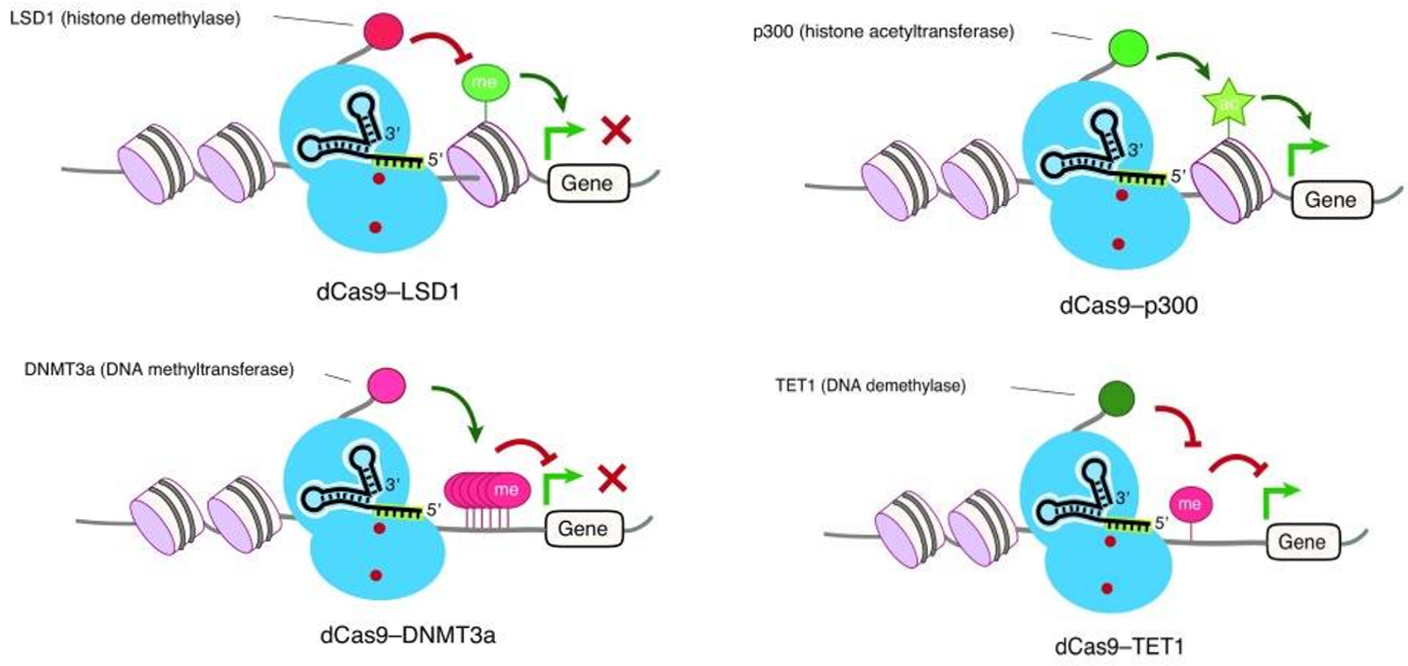
Our promise to you:
Guaranteed product quality, expert customer support.
 24x7 CUSTOMER SERVICE
24x7 CUSTOMER SERVICE
 CONTACT US TO ORDER
CONTACT US TO ORDER
CRISPR/Cas9-mediated Epigenetic Editing 
Although our genomic sequences provide instructions for coding cellular functions, epigenetic markers at specific genomic loci and histone residues determine the timing and level of implementation of these instructions. In mammals, there are three reported types of epigenetic modifications: methylation of DNA, post-translational modification of histones, and other regulation mediated by non-coding RNA. Epigenetic modifications of genes play important roles in different biological processes, including gene regulation, iPSC set reprogramming and maintenance, genomic imprinting, X chromosome inactivation, senescence, neurodegeneration, autoimmune regulation, and tumorigenesis.
Targeted rewriting of epigenome allows researchers to selectively modify apparent heritage markers at a given locus to explore how targeting epigenetic changes affect transcriptional regulation, the mechanism of subsequent phenotypes change, and the potential to treat epigenetic diseases especially for diseases with abnormal genetic or epigenetic marks (eg, Rett syndrome, Huntington's disease).
The CRISPR/Cas9 with the advantages of low cost and ease of use gives researchers the opportunity to manipulate the epigenome and observe its possible effects on cell function, development, and differentiation (Figure 1). Using non-active dCas9 (another type of Cas9 lacking nuclease activity but retaining DNA binding activity) fused enzymes such as DNA methylase, histone acetyltransferase, and deacetylase can be targeted to alter the epigenetic state of precise locations within the genome. Researchers have fused the catalytic core of human acetyltransferase p300 to dCas9 which shows that the system is sufficient to acetylate histone H3 lysine 27 at a specific target site and effectively activate transcription of the target gene. To target DNA methylation, a dCas9-based system was fused to the catalytic domain of DNMT to methylated CpG islands, which has been shown to induce higher methylation changes in larger genomic regions. dCas9 is also fused to the catalytic domain of TET1 to cause DNA demethylation. In addition, epiCas9s (Cas9 epigenetic effector) can be used for genome-wide screening to discover new relationships between epigenetic modifications, chromatin status, and phenotypes such as cell differentiation or disease progression. These findings highlight the potential of CRISPR/Cas9 in epigenetic research.
 Figure 1: CRISPR/Cas9-based epigenetic editing (Albert Lo, 2017)
Figure 1: CRISPR/Cas9-based epigenetic editing (Albert Lo, 2017)
As one of the leading gene editing companies, CRISPR/Cas9 PlatformCB is dedicated to supporting you conduct genetic research with comprehensive gene editing services and products. To perform targeted epigenetic modifications, CRISPR/Cas9 PlatformCB fuses dCas9 with epigenetic modifiers and designs your gRNA to target specific gene loci you are interested in. Tell us your needs, we offer custom CRISPR/Cas9 epigenetic editing solutions including gRNA design and synthesis, dCas9 mRNA synthesis, etc., which will be available for the study of epigenetic modifications effects on gene functions, and the relationship with epigenetic diseases.
Available modifications include:
- Histone acetylation to p300
- Histone demethylation of LSD1
- Cytosine methylation of DNMT3A or MQ1
- Cytosine demethylation of Tet1
References
- Julian Pulecio. et al. CRISPR/Cas9-Based Engineering of the Epigenome. Cell. 2017; 21(4): P431-447.
- Nina Xie. et al. Novel Epigenetic Techniques Provided by the CRISPR/Cas9 System. Stem Cells Int. 2018; 2018: 7834175.
- Albert Lo, Lei Qi. Genetic and epigenetic control of gene expression by CRISPR–Cas systems. F1000Research. 2017